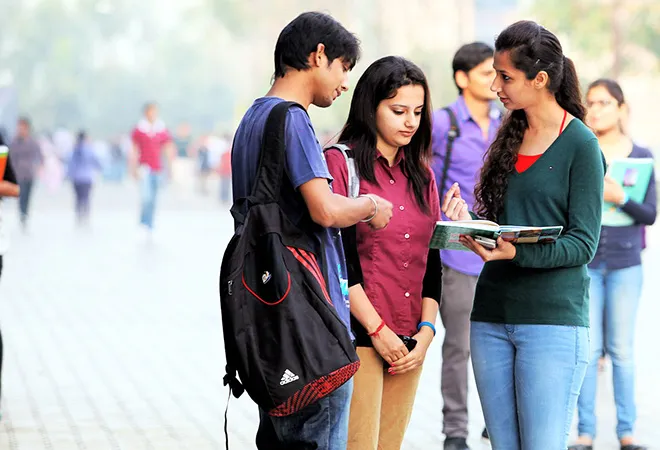
The United Nations General Assembly (UNGA) passed Resolution 69/145 in November 2014 recognising 15 July as World Youth Skills Day (WYSD). The General Assembly is concerned over the large number of young people who are unemployed globally, estimated at
74.5 million in 2013 and most of whom live in developing countries. Since then, the day commemorates the importance of skilling young people for employment, suitable work, and entrepreneurship. Skill development and jobs for youth prominently feature in the 2030 Agenda for Sustainable Development. The Sustainable Development Goals (SDGs) target 4.4 calls for a significant increase in the number of youth and adults with relevant skills while
target 8.6 urges for a significant decrease in the percentage of youth who are not in employment, education, or training (NEET) status in the next 15 years. The theme of the 2022 World Young Skills Development day is “Transforming youth skills for the future”. The theme draws attention to endowing the youth with skills that can make them resilient to evolving challenges, improve their productivity in jobs, increase employability, and prepare them for the future.
The day commemorates the importance of skilling young people for employment, suitable work, and entrepreneurship. Skill development and jobs for youth prominently feature in the 2030 Agenda for Sustainable Development.
According to
UN demographic projections, there are 1.8 billion young people (15–29 years) in the world. Twenty percent of the world's youth, or nearly 366 million people, live in India. In terms of India’s own population, the latest estimates show that around
27 percent of the total population of 1.3 billion in 2020 are youth while nearly
542 million people are of working age (15 to 64 years ). India’s labour market is second only to China's and much bigger than those of the United States and the European Union (EU). This is not it; India is expected to add another 183 million people to the working age group between 2020–50 resulting in 22 percent of the incremental global workforce coming from India in the next three decades. India also has the distinction of a high rate of unemployment. The
unemployability rate amongst youth in India stood at 54.1 percent in 2021 as opposed to 53.79 percent in the year before. The employability rate has shown a
marginal improvement over its previous year from 45.97 percent in 2020 to 46.2 percent in 2021. The share of
salaried employment in the country which stood at 21.9 percent in 2018–19 fell to 21.3 percent in 2019–20, and the
informal sector employs over 90 percent of the workforce in India. The lack of employability raises concerns about the standard of education offered in India’s secondary education and higher institutions, and the quality of technical and vocational education and training (TVET) infrastructure.
In recent years, India has launched a variety of initiatives, programmes, and schemes for skill development and vocational training and education under the “Skill India Mission” including National Skill Development Mission (NSDM), Pradhan Mantri Kaushal Vikas Yojana (PMKVY), National Policy on Skill Development and Entrepreneurship, Indian Skill Development Service (ISDS), Jan Shikshan Sansthan (JSS), SANKALP. However, despite these programmes and schemes, the unemployment among Indian youth is high to the tune of 28.26 percent in 2021, which was 24.9 percent in 2020 and 23 percent in 2018 indicating that the existing institutional training framework needs to be revamped. In 2019-20, of the 542 million people, only
73 million or nearly 13 percent received any form of vocational training and only 3 percent were formally skilled. In comparative terms, 24 percent of the workers in China are skilled, 52 percent in USA, 68 percent in UK, and 80 percent in Japan.
The share of salaried employment in the country which stood at 21.9 percent in 2018–19 fell to 21.3 percent in 2019–20, and the informal sector employs over 90 percent of the workforce in India.
Addressing the skill deficit
In the globalised world, where competition amongst firms and industries has intensified, workers are required to have higher levels of skills which can
enable them to engage in innovation, improve the quality of products/services, and increase their efficiency in production processes to the extent that the whole value chain linkages are improved. Embracing rapid technological changes requires specialised knowledge and skills in producing, applying, and spreading the reach of technologies. With India undergoing digital transformation, economic opportunities will continue to emerge for the youth to explore and benefit from. However, to take advantage of such opportunities, skilling and upskilling of the people are urgently required in the country. Skill development and enhancing skilling capabilities pose a massive challenge to unlocking the USD 1 trillion digital economy potential by 2025. The skill deficit in India can be attributed to many factors starting with the lack of integration of skill development and education during schooling for skills to
takeoff. Poor digital access, lack of digital competency, poor internet connection and access to relevant devices, and high data costs have further exacerbated the problem. As many as
27 million people representing 7 percent of the workforce in India require digital skills.
The additional employment potential through upskilling cannot be undermined; 2.3 million additional jobs are expected by 2030, second only to the US which is likely to generate 2.7 million additional jobs.
Given that India has a large "demographic dividend"—the majority of its people are under 30, close to
1.25 million new workers (in the age group 15–29) are projected to join India’s workforce every month in 2022. Creating well-paying and productive jobs for these new workers will remain a major challenge for India. Education and skill development can enable realising this dividend. The additional employment potential through upskilling cannot be undermined;
2.3 million additional jobs are expected by 2030, second only to the US which is likely to generate 2.7 million additional jobs. Estimates suggest that investment in upskilling could potentially advance the global economy by US
$6.5 trillion and India's economy by US$570 billion by 2030.
While investments in human capital are critical to realising sustained economic growth, higher technical and vocational skills can improve the competitiveness of economies and contribute to social inclusion, productivity, and decent employment for all and reduction in poverty. The skill deficit in the workforce in India requires a policy and institutional framework that is based on a partnership between government, industry, providers of educational and training services, and civil society. Keeping in sync with the Sustainable Development Goals, the National Youth Policy-2021 envisages a 10- year vision for youth development in India to unlock the potential of youth in advancing economic growth. To be able to thrive in their jobs and sustain future work challenges, skilling, upskilling and reskilling of individuals will be key to aligning them with emerging technologies and opportunities.
The author acknowledges the contribution of Srishty Pandey for providing research input.
The views expressed above belong to the author(s). ORF research and analyses now available on Telegram! Click here to access our curated content — blogs, longforms and interviews.



 The United Nations General Assembly (UNGA) passed Resolution 69/145 in November 2014 recognising 15 July as World Youth Skills Day (WYSD). The General Assembly is concerned over the large number of young people who are unemployed globally, estimated at
The United Nations General Assembly (UNGA) passed Resolution 69/145 in November 2014 recognising 15 July as World Youth Skills Day (WYSD). The General Assembly is concerned over the large number of young people who are unemployed globally, estimated at PREV
PREV


